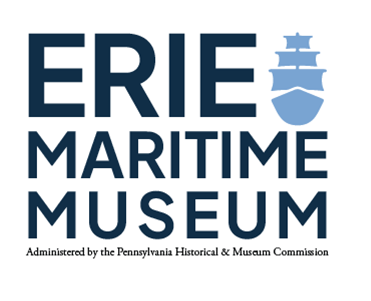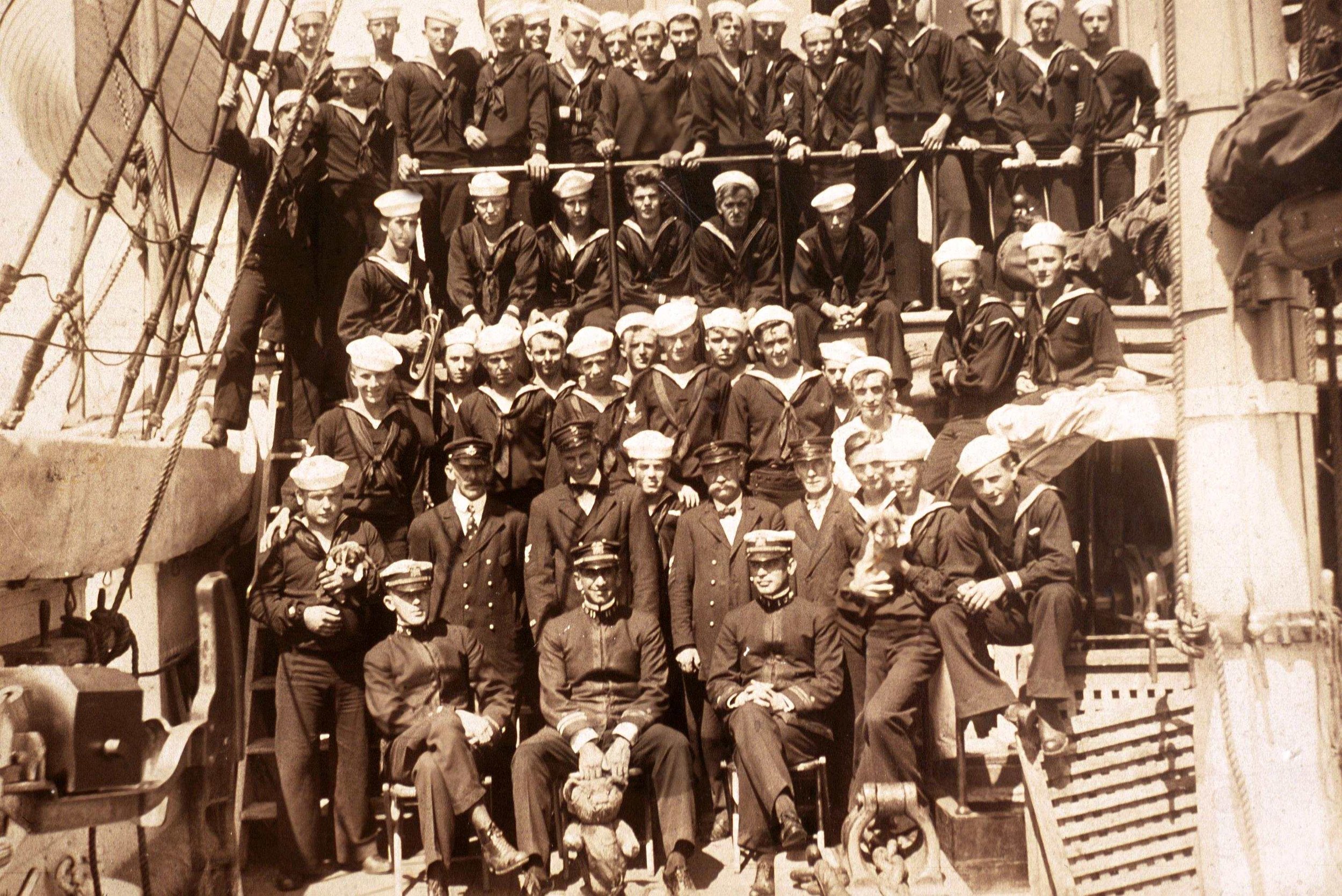U.S. Paddle Frigate Michigan
The United States Navy’s First Iron-Hulled Warship
The middle of the nineteenth century sparked a major revolution in the art of Western shipbuilding. For the first time since the dawn of ship construction, experiments in new forms of hull materials and increasingly tense global relations led navies around the world to construct hulls with iron. Evidence of this change can be found during a visit to the Erie Maritime Museum with a tour of the second-floor exhibit dedicated to the sailors of the USS Michigan/Wolverine - an exhibit that is anchored by the actual prow of the ship.
Erie, Pennsylvania was once recognized as the “mother-in-law of the United States Navy” due to the many young sailors who were sent to Erie to serve aboard USS Michigan/Wolverine that eventually met a girl and settled down in the region. The ship was constructed as a result of tensions with the British in the post-War of 1812 era and the increasingly connected world. She was ordered for construction on May 19, 1839, and designed by Samuel Hartt. Ironically, the iron was contracted out to Stackhouse and Tomlinson, the same company which produced the anchors for Oliver Hazard Perry during the War of 1812. The ship was ready to launch on December 5, 1843 however, she became stuck on the ways. She would eventually “launch herself in the night” and was discovered floating offshore in Lake Erie on the morning of December 6.
USS Michigan/Wolverine was homeported in Erie, Pennsylvania for 79 years! Learn more about the “Guardian of the Great Lakes” by visiting the Erie Maritime Museum’s second-floor exhibit honoring the ship’s eight-decade career and the men who crewed her. In the meantime, check out the statistics and information below.
“I determined to build this vessel of iron instead of wood, for two reasons. In the first place, I was desirous to aid, as far as I could, in developing and applying to a new use, the immense resources of our country in that most valuable metal; and, in the second place, it appeared to me to be an object of great public interest to ascertain the practicability and utility of building vessels, as least for harbor defense, or so cheap and indestructible a material.”
Ship Specifications
-
Length (Overall) - 176’-6”
Length (On Deck) - 167’-6”
Length Between Perpendiculars - 162’-6”
Length of Keel - 156’
Beam to Outside of Hull - 27’
Extreme beam to outside of paddle boxes - 45’-10”
Height from top of keel to top of rail - 17’-10”
Weight of iron in hull - 236 tons
Tonnage - 582 tons Burthen / 685 tons Displacement
-
Length of foreyard - 66’
Length of topsail yard - 50’
Length of topgallant yard - 30’-6”
Height of mainmast to truck - 83’
Length of forward end of jobboom to after end of spanker boom - 223’
-
2 Cylinders: Diameter 36” / Stroke of 96” - Inclined 20.5
2 Iron Boilers: Flue or Fire Tube construction - 810 tubes in each
Indicated Horsepower - 170 at Operating Temperature of 15 psi
Design Speed - 8.5 knots (on trials - 12 knots). In 1848, 14 knots
Live steam could actually be vented to hoses on deck for use in repelling boarders.
-
$152,478.71 (1843)
$5,222,395.82 (2022, adjusted for inflation)
(Similarly sized wooden ships were approximately $320,000)
-
2-64 pdr. - 8” shell guns, pivot mounted bow and stern
14-32 pdr. - Smooth Bore / 41 cwt.
-
2- 64 pdr. - 8” Shell Guns, pivot mounted, bow and stern
4- 32 pdr. Carronades
-
1-64 pdr. 8” Shell Guns, pivot mounted in the bow
-
1- 64 pdr. - 8” Shell Guns, pivot mounted in the bow
1-30 pdr. Parrott Rifle
6-24 pdr. Dahlgren Howitzers
5-20 pdr. Parrott Rifles
2-12 pdr. Dahlgren Howitzers
-
6-3” - Breach-Loading Rifled Howitzers
2-12” pdr. Dahlgren Howitzers
-
6-3” Breach-Loading Rifled Howitzers
1 Gatling Gun
-
6-3” Breach-Loading Rifled Howitzers
2 Gatling Guns
-
4- 4.2” Breach-Loading Parrott Rifles (converted 32 pdrs.)
1-3” Breach-Loading Rifled Howitzer
1- .45 caliber Gatling Gun (new model)
-
4-4.2” Breech-Loading Parrott Rifles (converted 32 pdrs.)
3-3” Breech-Loading Rifled Howitzers
2-.45 caliber Gatling Guns
-
2-6 pdr. Hotchkiss quick-fire guns
2-1 pdr. Hotchkiss quick-fire guns
2-.45 caliber Gatling Guns
-
2-3 pdr. Hotchkiss quick-fire guns
Ordnance Carried (by Year)
Chronology: USS Michigan / Wolverine
-
The Upper Canada Rebellion increases tensions between the US & Britain.
-
As a result of these increased tensions the US Congress authorizes the sum of $100,000 for the construction of armed steamers on Lake Erie.
-
The Commissioners of the US Navy decide to use these funds to build an Iron Hulled Warship for the use of the Great Lakes.
-
Naval Constructor Samuel Hartt designs an Iron Hulled vessel to be fabricated by the firm Stackhouse & Tomlinson at Pittsburgh. The pieces are shipped to Cleveland via the newly opened Ohio-Erie Canal and then to Erie by steamer.
-
Ship is reassembled at Erie and launched on December 4th and 5th. It was christened on December 7th.
-
Fitting Out continues at Erie throughout the Summer. USS Michigan is formally placed in commission on the 20th of September.
-
Beaver Island - Mackinaw War (part 1). Arrest and acquittal of Mormon leader James Strang.
-
Operations against the “Timber Pireates”.
“Collision” with the Steamer Buffalo.
-
Beaver Island - Mackinaw War (part II): Assassination of James Strang, dispersal of Mormon Colony on Beaver Island.
-
The Michigan spends the Civil War acting as a floating recruiting station or guarding the POW Camp on Johnson’s Island near Sandusky, Ohio. She also helps quell Draft Riots in Chicago, Illinois.
-
On September 21st, an attempt to seize the ship and release prisoners at Johnson’s Island by Confederate agents operating out of Canada is foiled.
-
During the Fenian Raids, the Michigan is sent to Buffalo, New York to operate against Fenian Raiders attempting to cross into Canada.
-
The ship is painted white for the Columbian Centennial Celebration.
-
The ship is given a major refit, including an enlarged Pilot House.
-
On June 17th, the ship is renamed USS Wolverine to free up the name Michigan for the new Dreadnought Battleship, Michigan.
-
On May 6th, the Wolverine is decommissioned by the Navy and turned over to the Pennsylvania Naval Militia for use as a training ship. She conducts summer training cruises on the lakes until 1923.
-
The Crew of the USS Wolverine were ordered to mobilize after the US entered World War I. America was at war and these men were some of the first in Erie county to see active service in the Great War.
-
The USS Wolverine conducts her final cruise. On August 12th, a connecting rod on one of her cylinders breaks on Lake Michigan. She limped back to Erie and is finally laid up when the Navy refuses to fund repairs.
-
The Wolverine is loaned to the City of Erie by the Navy. She is towed to Misery Bay and moored near the Perry Monument.
-
After a failed attempt to raise money for her preservation, she is cut up for scrap.
-
Her Bow and Cutwater are erected as a monument at the Foot of State Street, not far the from the shipyard where she was built 93 years earlier.
-
Her Bow and cutwater are moved into the newly opened Erie Maritime Museum.
-
The USS Michigan/USS Wolverine exhibit opens at the Erie Maritime Museum.




